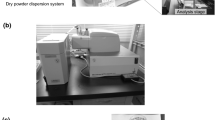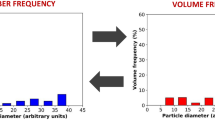Abstract
IN determining the size distribution of particles in samples of finely ground barytes, difficulties have been experienced in determining experimentally the ultimate balance reading corresponding to sedimentation equilibrium1. It takes an inordinately long time for equilibrium to be attained, and even then this does not necessarily represent complete sedimentation of all solid particles. Consequently, even at equilibrium the balance reading (S∞) will be less than the theoretical maximum reading corresponding to the weight of solid introduced (Sm).
Similar content being viewed by others
References
Bostock, W., J. Sci. Inst., 29, 209 (1952).
Harris, C. C., J. App. Phys., 31, 215 (1960).
Heywood, H., Recent Developments in Mineral Dressing, 31 (I.M.M. London, 1953).
Frangiskos, N. Z., Harris, C. C., and Jowett, A., Third Intern. Cong. Surface Activity, Paper D46 (Cologne, 1960).
Author information
Authors and Affiliations
Rights and permissions
About this article
Cite this article
HARRIS, C., JOWETT, A. Sub-sieve Sizing by Sedimentation Balance. Nature 197, 1192–1193 (1963). https://doi.org/10.1038/1971192b0
Issue Date:
DOI: https://doi.org/10.1038/1971192b0
- Springer Nature Limited
This article is cited by
-
Photosedimentation analysis of powders
Soviet Powder Metallurgy and Metal Ceramics (1970)
-
Size Analysis in the Sub-sieve Range by Electronic Counter
Nature (1965)





